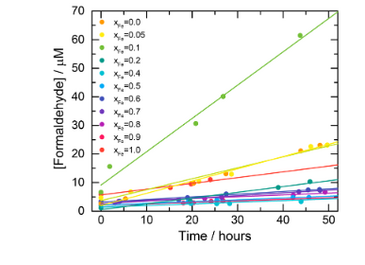M. Curti , A. Kirsch, L. I. Granone∥ , F. Tarasi, G. López-Robledo, D. W. Bahnemann∥ , M. M. Murshed, T.M. Gesing , C. B. Mendive
ACC Catalysis (2018) 8, 8844-8855.
http://dx.doi.org/10.1021/acscatal.8b01210
The rich crystal chemistry of mullite-type Bi2M4O9 (M = Fe, Al, Ga) offers multiple potential applications. In particular, the strong absorption of visible light shown by Bi2Fe4O9 has led to an influx of research on its photocatalytic properties. However, most of the published studies involve the decolorization of dyes and take it as proof of its photocatalytic activity; furthermore, there are no reports on its conduction and valence band edges, and, thus, the actual redox characteristics of the photogenerated charge carriers have not been determined. Here, we evaluate the photocatalytic activity toward methanol oxidation under monochromatic visible light (λ = 450 nm) irradiation of 12 different members of the Bi2(Al1–xFex)4O9 (x = 0–1) series of compounds. The reaction rate reaches its highest value at an iron fraction of x = 0.1, while the compounds with the highest iron fractions present negligible activity. Based on an extensive characterization, which included the Rietveld refinement of the XRD patterns, the measurement of the specific surface areas by the BET method, and the determination of the flat-band potentials by the Mott–Schottky method, we rationalize the results on the basis of two opposing factors: the incorporation of iron narrows the fundamental bandgap and thus improves light capture, but at the same time it lowers the conduction band edge, hindering the oxygen reduction half-reaction and thus promoting electron–hole recombination. Our work highlights the importance of a proper band edge engineering for photocatalytic applications and underlines the inadequacy of dye decolorization tests for visible-light-active materials.


